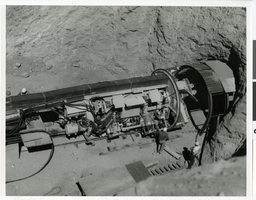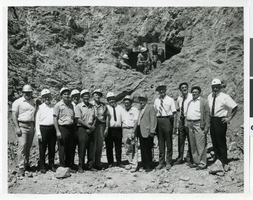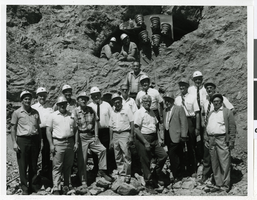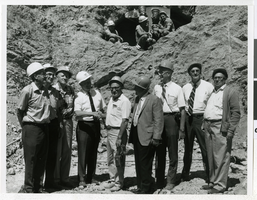Search the Special Collections and Archives Portal
Search Results

Photograph of the outlet portal showing the mole preparing to walk into the tunnel on the Las Vegas River Mountain Project, Las Vegas, Nevada, circa 1968-1971
Date
Archival Collection
Description
Image

Photograph of Key federal, state and contractor representatives who were on hand when the mole broke through the tunnel, Las Vegas, Nevada, 6-26-69
Date
Archival Collection
Description
Image

Photograph of Key federal, state and contractor representatives who were on hand when the mole broke through the tunnel, Las Vegas, Nevada, 6-26-69
Date
Archival Collection
Description
Image

Photograph of Key federal, state and contractor representatives who were on hand when the mole broke through the tunnel, Las Vegas, Nevada, 6-26-69
Date
Archival Collection
Description
Image
Jay Sarno Papers
Identifier
Abstract
This collection is comprised of publicity and promotional materials documenting the Caesar's Palace Hotel and Casino Resort and the Circus Circus Hotel and Casino Resort. Both resorts were a result of hotel and casino developer Jay Sarno. There is a small amount of material on Sarno in the collection such as newspaper clippings, a press release, and a copy of Sarno's FBI investigation file. The collection includes property records, magazine and newspaper clippings, informational brochures from the two properties, press kits, and a small amount of correspondence. It also includes a prospectus and stock offerings for Sarno's never-realized Grandissimo Hotel and Casino resort that would have been built on Interstate 15 to the west of the Las Vegas Strip.
Archival Collection
Von Tobel Family Papers
Identifier
Abstract
The Von Tobel Family Papers (1905-1997) consist of photographs, correspondence, and financial reports pertaining to the early Las Vegas Von Tobel family and their businesses, which they operated in Las Vegas, Nevada. The collection also contains newspaper clippings covering the life of Edward Von Tobel Sr. and some of the operational business records of the Von Tobel Hardware Store No. 301.
Archival Collection
Eileen Brookman Papers
Identifier
Abstract
The Eileen Brookman Papers date from 1934 to 2002 and document Brookman's personal life and political career. Brookman was active in the Las Vegas Jewish community. Personal papers include programs from B'nai B'rith, scrapbook materials, correspondence, and photographs. The collection includes documentation from the White House Conference on Aging. She served several terms in the Nevada State Assembly from 1967 to 1977 and again from 1987 to 1989. Political materials include legislative information, bumper stickers, election returns, and newspaper clippings.
Archival Collection
Doris Hancock Papers
Identifier
Abstract
The Doris Hancock Papers (1895-1987) consist of school memorabilia, correspondence, sketches, two scrapbooks, and material from her involvement in the Las Vegas Art League. Also included are materials about Southern Nevada and surrounding areas, particularly mining towns, Colorado River, Boulder Dam, Red Rock Canyon, early Las Vegas, and Death Valley.
Archival Collection
Minsky's Burlesque Records
Identifier
Abstract
Minsky's Burlesque Records (1922-1978) contain scripts, publicity, photographs, financial records, payroll records, sheet music, newspaper clippings, contracts, and correspondence. Also included are the personal papers of noted burlesque producer Harold Minsky, who was known for creating the "family burlesque" style of entertainment and for introducing the topless showgirl to Las Vegas, Nevada at the Dunes Hotel in 1957.
Archival Collection
Carolyn Merriam Collection on the Sands Hotel
Identifier
Abstract
The Carolyn Merriam Collection on the Sands Hotel (1972-1998) consists primarily of Sands Hotel merchandise and ephemera, including mugs, glassware, playing cards, dice, an ashtray, and a tote bag. The collection also contains several framed photograph reproductions depicting Las Vegas, Nevada in the 1950s and 1960s. The Sands Hotel operated in Las Vegas, Nevada from 1952 to 1996.
Archival Collection
